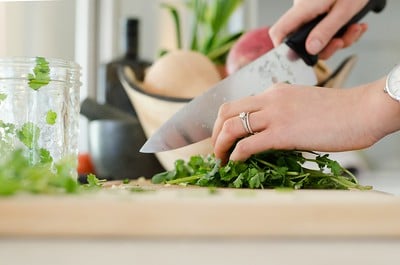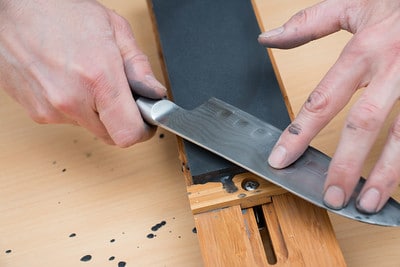Have you ever been puzzled about how to use a knife sharpener? If your knives seem to have gone dull after a while of use, you may need to invest in a knife sharpener to get the blades back into great condition. Just like many items, a knife blade can deteriorate over time, with burrs and knicks on the cutting edge lessening its performance.
Learning the art of knife sharpening ensure you can transform a dull knife into a sharp one with very little time and effort. This means you don’t have to throw your knives away whenever they’re not working as well as you’d hope.
The crucial thing to remember is you need to make sure you’re using your knife sharpener correctly so you don’t end up causing more damage to the blade. Here’s everything you need to know about using a knife sharpener properly.
How to Know When to Start Sharpening a Knife
Good knives need regular sharpening to maintain a good cutting edge. If you want to keep your knives in good condition, you should be testing their sharpness on a regular basis.

You can test the quality of your knife by cutting through a slice of paper or chopping a tomato or onion. A sharp blade should cut through a tomato without squashing it. And it should also be able to easily cut through an onion’s outer skin.
If your kitchen knife seems to be crushing food rather than slicing through it, this is a sign of a dull blade. Problems with sharpness are so common after regular use that many knife blocks will already come with sharpening tools built-in. For instance, you can get a knife block with its sharpening rod. While it’s important to sharpen your knife’s edge regularly, try to avoid sharpening too much, as this can wear down your blade.
The Best Way to Sharpen a Knife
The best way to sharpen a knife will depend on your preferences. Some people like using a rectangular block of honing steel or a manual knife sharpener with fine grit. Other people find it easier to use electric knife sharpeners, as manual sharpeners can be difficult to master.
Your common options for sharpening a knife will include:
Manual Sharpeners
These include pull-through sharpeners with fine grit on one side, honing rods, or a sharpening rod. You use these tools for manually sharpening your knives using an edge with a coarse texture.
Electric Knife Sharpeners
An electric knife sharpener will come with two or three slots for sharpening kitchen knives and similar utensils. These tools are great for sharpening and honing a knife, depending on the product you choose.
Whetstone
The whetstone, a traditional knife sharpening method, is a great way to sharpen a knife-edge using a block with coarse grit and a fine grit side. This is the most precise method of sharpening a knife, but it can be difficult to master.

How Many Times Should you Run a Knife Through a Sharpener?
Knife sharpening takes some practice. The number of times you need to run the entire edge of your blade through a sharpener will depend on several factors, including whether you’re using manual or electric tools. You’ll also need to think about how dull the blade’s edge is.
Manual Sharpeners
If you’re using a manual sharpener, it’s a good idea to pull your knives through the coarse slot of the sharpener using the same motion with your dominant hand, around 3 to 6 times. You can test the blade using the methods above (such as the paper or tomato test). Finish the sharpening process with one or two pulls through the fine grind side.
Electric Sharpeners
If you’re using an electric sharpener, you’ll need to pull the entire length of the knife through the slots smoothly and carefully, allowing the motorised system inside to do the work. Follow the guidelines given by the instructions, but you’ll usually stick to the same three to six pulls through most sharpening tools.
The number of pulls you need to get your knife sharp will depend on whether you’re using the fine grit slot, the coarse grit slot, or a combination of the two.
Using a Knife Sharpener: An Easy Guide
There are different techniques to get a sharp edge on your knife, depending on whether you’re using sharpening stones, a handheld sharpener, or an electronic one. You’ll find some guidance in the manufacturer’s instructions which can be quite helpful.
Make sure you pay attention to the instructions when using a different type of knife tip, too. For instance, you may not need to sharpen the blade’s edge on Japanese knives as thoroughly as you would on a steel blade.
How to Sharpen a Knife With a Handheld Sharpener
Learning how to use a knife sharpener can be a very different experience, depending on which tool you’re using. Knife sharpening can be a lot faster and more straightforward when you’re sharpening steel with electric knife sharpeners. However, manual knife sharpeners do give you more precision and control.
Handheld sharpeners come in a variety of forms, but they’re all designed to keep your blades sharp. From a sharpening stone to manual multi-point sharpeners similar to an electric sharpener, there’s something for everyone.
Using a Basic Manual Sharpener
To begin, place the sharpener on your work surface or counter, holding the handle with your non-dominant hand. Hold it firmly to keep the sharpener from moving during use. Next, grip the knife by the handle, keeping your fingers behind the heel.
Insert the knife into the slot and pull the knife handle-first towards yourself smoothly. Each pull should only take a few seconds. You can test your knife’s sharpness after a few pulls to see if you need to continue.
Using a Whetstone Sharpener
If you prefer to use sharpening surfaces to handheld knife sharpeners, you can use something like a whetstone with a coarse grind.
Put some water on the stone until it’s completely saturated, then place it coarse-side up on the counter. Grip the handle and gently drag the knife’s heel down the whetstone towards you, keeping the blade at a consistent angle.
Make sure you keep the blade touching the stone as you work.
Using a 3-Slot Knife Sharpener
In most cases, a three-slot or multi-stage handheld knife sharpener will have several settings to choose from, including a coarse setting, a fine setting, and a honing slot. Start with the coarse slot if your knives need more than just a touch-up.
Step 1: Pull the Blade Through the Coarse Setting
Run your blade’s edge through the coarse side of the sharpener three to six times, depending on how dull the blade is. The coarse edge is good for knives that need to be replaced. However, you won’t need to use this setting to sharpen your knife every day.
Step 2: Follow the Contour of the Blade
Make sure you’re only applying slight pressure when moving the knife through the system and moving the blade, so you’re following the contour. If you’re pressing too hard and damaging the blade, you should be able to tell by the noise or its resistance.
Step 3: Use the Fine Setting
Run the blade through the fine setting one or two times to finish the blade off and refine the sharp edge. Ensure you’re not placing too much pressure on the knife tip when using the sharpener.
Step 4: Use the Honing Setting
Use the honing slot on your knife sharpener if you feel you need to push the edge of the knife upwards towards the centre at the correct angle.
Step 5: Rinse the Knife
When you’re done sharpening a kitchen knife, make sure you rinse it off with water to remove any lingering remnants of steel before you use it again. Then dry the blade thoroughly before returning it to its knife block.
You should be able to maintain your knife by running it through the “fine setting” on the block daily. The general rule of thumb is that you’ll need to use the fine setting once every two hours or so of use with your knife.
Is Sharpening a Knife Different to Honing a Knife?
Setting time aside for regularly sharpening kitchen knives is important in ensuring your tools stand the test of time. A sharp knife can slice through vegetables, meat, and other ingredients more quickly and precisely, so you can finish cooking tasks in no time.
Sharp knives allow you to make precise cuts, which can make a difference when determining your meals’ flavour, texture, and even cooking times. At the same time, sharpening knives is a good way to improve kitchen safety. When you’re struggling with a knife-edge, it’s much easier to slip and cause injuries.
So, how is sharpening a knife different to honing one?
Sharpening a knife is the process of actually removing material from the edge of a knife to produce a newer, sharper edge. Think of it as cutting a fingernail into a new shape. Alternatively, honing a knife involves putting the knife’s edge back towards the centre. You’re more likely to use honing for serrated knives, whereas you can sharpen knives with a straight edge.
Keeping Your Knives Sharp
Learning how to use a knife sharpener doesn’t have to be as complex as it seems. Whether you’re using electric or manual knife sharpeners, the process only takes a little practice to get used to. You might even decide to use sharpening stones in the long term so you can have great precision.
Whatever your choice is, regularly using your devices will help keep your blade sharp. In this way, you don’t have to throw your knife away and replace it with a sharp one every time the edge starts to get dull.
Additional Resources
- When Was the Can Opener Invented
- How to Use a Can Opener
- How Does an Electric Cool Box Work
- What Is a Paddle Attachment for a Hand Mixer
Tom is a former chef turned full-time food blogger. He has always been passionate about food, and loves nothing more than experimenting in the kitchen and sharing his recipes with others. Tom’s blog is one of the most popular food blogs on the internet, and he has won numerous awards for his cooking. When he’s not blogging or cooking, Tom enjoys spending time with his wife and two young children.

